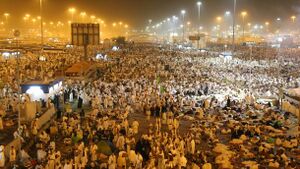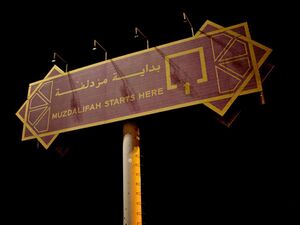Muzdalifa
 | |
| General Information | |
|---|---|
| Other Names | Jam', Quzah and al-Mash'ar al-Haram |
| Place | Mecca, Between Mina and 'Arafat, at a distance of 6 kilometers from Arafat, and 8 kilometers southeast of al-Masjid al-Haram |
| Usage | Pilgrim's staying place on the 10th night Dhu al-Hijja |
| Current State | |
| 9.63 square kilometers | |
| Status | Active |
Muzdalifa (Arabic: مزدلفة, approaching) is a location near Mecca where hajj pilgrims must perform the ritual of wuquf after their nighttime journey from Arafat. Its name, "Muzdalifa," means "approaching" or "meeting place," reflecting its role as a gathering point for pilgrims. It's also known as "Jam'" meaning "gathering." This sacred site is the same al-Mash'ar al-Haram mentioned in the Quran.
Muzdalifa, a 9.63 square kilometer area, is situated between Mina and 'Arafat, bordered by Wadi l-Ma'zamayn and al-Hiyaz. Staying in Muzdalifa on the 10th night of Dhu al-Hijja is a mandatory part of the hajj pilgrimage.
Meaning
Muzdalifa is derived from the Arabic infinitive "izdilaf" (ازدلاف), meaning "to approach" or "to draw near." The phrase "izdalaf-a al-qawm" (ازدلف القوم) translates to "the people approached" or "the people gathered." Thus, the name Muzdalifa signifies the gathering of pilgrims at this location.[1]
Among the other names of Muzdalifa are Jam'(means: gathering)[2], Quzah[3] and Mash'ar al-Haram[4]. It has been said that applying the name of Mash'ar to Muzdalifa is virtual, which means that Muzdalifa is actually a part of the land of Mash'ar and within its boundaries; But it is also called Mash'ar.[5]
It has other names as well:
- Al-Jam' (الجَمْع) signifying "gathering"[6]
- Al-Quzah (القُزَح)[7]
- Al-Mash'ar al-Haram (المشعر الحرام)[8] Scholars debate whether Muzdalifa itself is literally the al-Mash'ar al-Haram or a part of its broader territory.[9]
Location

Muzdalifa is situated between Mina and 'Arafat, and the valley of Wadi l-Mohassir (Arabc: وادی المحَسِّر) lies between Mina and Muzdalifa.[10] The distance between Muzdalifa and 'Arafat is approximately 6 kilometers, while it is 8 kilometers from the southeast of the al-Masjid al-Haram. The total area of Muzdalifa is roughly 9.63 square kilometers.
Muzdalifa is bordered on one side by the valley of al-Ma'zamayn (مأزَمَین) and on the other by Wadi Muhassir and Hiyad. Pilgrims reach Muzdalifa, also known as the al-Mash'ar al-Haram, by passing through Wadi l-Ma'zamayn.[11]
Rulings
Wuquf (standing) in Muzdalifa is a mandatory pillar of the hajj pilgrimage, performed on the 10th night of Dhu al-Hijjah. This is a consensus among all Islamic sects. However, there are varying opinions regarding the duration and specific timing of the wuquf.[12]
Shia's View
According to Shia jurists, hajj pilgrims should reach al-Mash'ar al-Haram (Muzdalifa) anytime between the 10th night of Dhu al-Hijjah and dawn with the intention of fulfilling their religious duty. Staying in al-Mash'ar al-Haram until sunrise with a pure intention of worship is considered valid. It is recommended to begin the journey towards Mina shortly before sunrise, avoiding crossing Wadi Muhassir until the sun rises.[13]
Sunni's View
Abu Hanifah mentions the time of wuquf from dawn to sunrise, and Malik believes that it is sufficient for a pilgrim to make a wuquf any time during the night of Eid al-Adha and before dawn. According to al-Shafi'i, staying at any moment after midnight of Eid al-Adha is sufficient.[14]
Boundaries
Muzdalifa extends approximately 3,812 meters from the start of al-Mazamayn (the gorge between Muzdalifa and 'Arafat) to the beginning of Wadi Muhassir.[15]. The distance between the Banu Shayba Gate of Masjid al-Haram and the Muzdalifa border on the Mina side is approximately 20,507 cubits.[16]
The boundaries of Muzdalifa are marked with large signs, and with the words "the beginning of Muzdalifa" (Arabic: بداية مزدلفه) or "the end of Muzdalifa" (Arabic: نهاية مزدلفه), you can know its limits.
Notes
- ↑ Ṭurayḥī, Majma' al-baḥrayn, vol. 5, p. 68.
- ↑ Ṭurayḥī, Majma' al-baḥrayn, vol. 2, p. 186.
- ↑ Ni'matī, Qāmūs al-ḥaramayn al-sharīfayn, p. 86.
- ↑ Ni'matī, Qāmūs al-ḥaramayn al-sharīfayn, p. 204.
- ↑ Al-Jawāhirī, حدود عرفات، مزدلفة، منیThe boundaries of 'Arafat, Muzdalifa, Mina, p. 157-158.
- ↑ Ṭurayḥī, Majma' al-baḥrayn, vol. 2, p. 186.
- ↑ Ni'matī, Qāmūs al-ḥaramayn al-sharīfayn, p. 86.
- ↑ Ni'matī, Qāmūs al-ḥaramayn al-sharīfayn, p. 204.
- ↑ Al-Jawāhirī, حدود عرفات، مزدلفة، منیThe boundaries of 'Arafat, Muzdalifa, Mina, p. 157-158.
- ↑ 'Aṭṭār, Qāmūs al-ḥaj wa al-'Umra, p. 204.
- ↑ Murwārīd, Yanābī' al-fighīyya, vol. 7, p. 198.
- ↑ Qāḍī 'Askar, Ḥajj dar andīsha-yi islāmī, p. 288; Fallāḥzāda, Darsnāma-yi manāsik-i Ḥajj, p. 62; 'Aṭṭār, Qāmūs al-ḥaj wa al-'Umra, p. 252.
- ↑ Fallāḥzāda, Darsnāma-yi manāsik-i Ḥajj, p. 62.
- ↑ 'Aṭṭār, Qāmūs al-ḥaj wa al-'Umra, p. 252.
- ↑ Ṣabrī Pāshā, Mawsū'a mirʾāt al-ḥaramayn, vol. 1, p. 341.
- ↑ Fāsī, Shifāʾ al-gharām, vol. 1, p. 505, 507.
References
- Al-Jawāhirī, Ḥasan Muḥammad Taqī. حدود عرفات، مزدلفة، منی (Translation: The boundaries of 'Arafat, Muzdalifa, Mina). Miqāt al-ḥajj magazine, 1415 AH.
- ʿAṭṭār, Aḥmad ʿAbd al-Qafūr. Qāmūs al-ḥajj wa l-ʿumra. Beirut: Dār al-ʿIlm li-l-Malāyīn, 1979.
- Fallāḥzāda, Muḥammad Ḥusayn. Darsnāma-yi manāsik-i ḥajj’’. Tehran: Mash'ar, 1389 Sh.
- Fāsī al-Makkī, Muḥammad b. Aḥmad. Shifāʾ al-gharām bi-akhbār al-balad al-ḥarām. Translated by Muḥammad Muqaddas. Tehran: Mash'ar, 1386 Sh.
- Murwārīd, ʿAlī Aṣghar. Al-Yanābīʿ al-fighīyya. Beirut: [n.p], 1410 AH.
- Niʿmatī, Muḥammad Riḍā.Qāmūs al-ḥaramayn al-sharīfayn. Tehran: Mashʿar, 1418 AH.
- Qāḍīʿaskar, ʿAlī. ‘’Ḥajj dar andīsha-yi Islāmī’’. Tehran: Mashʿar, 1384 Sh.
- Ṣabrī Pāshā, Ayyūb. Mawsūʿa mirʾāt al-ḥaramayn. Translated by ʿAbd al-Rasūl Munshī. Tehran: Markaz-i Pazhūhishī-yi Mīrāth-i Maktūb, 1382 Sh.
- Ṭurayḥī, Fakhr al-Dīn b. Muḥammad al-. Majmaʿ al-baḥrayn. Edited by Sayyid Aḥmad Ḥusaynī. Tehran: al-Maktaba al-Murtaḍawīyya, 1375 Sh.